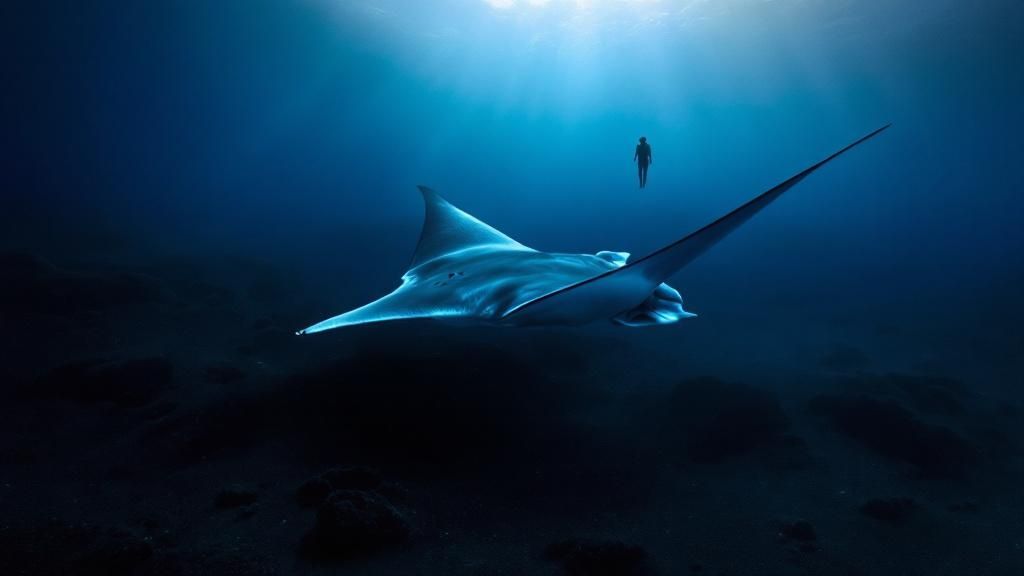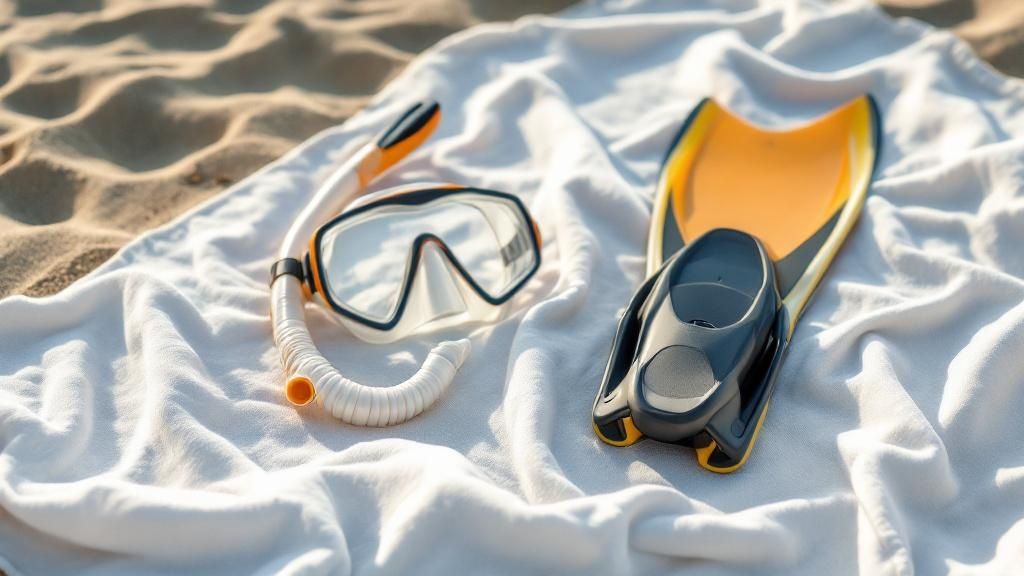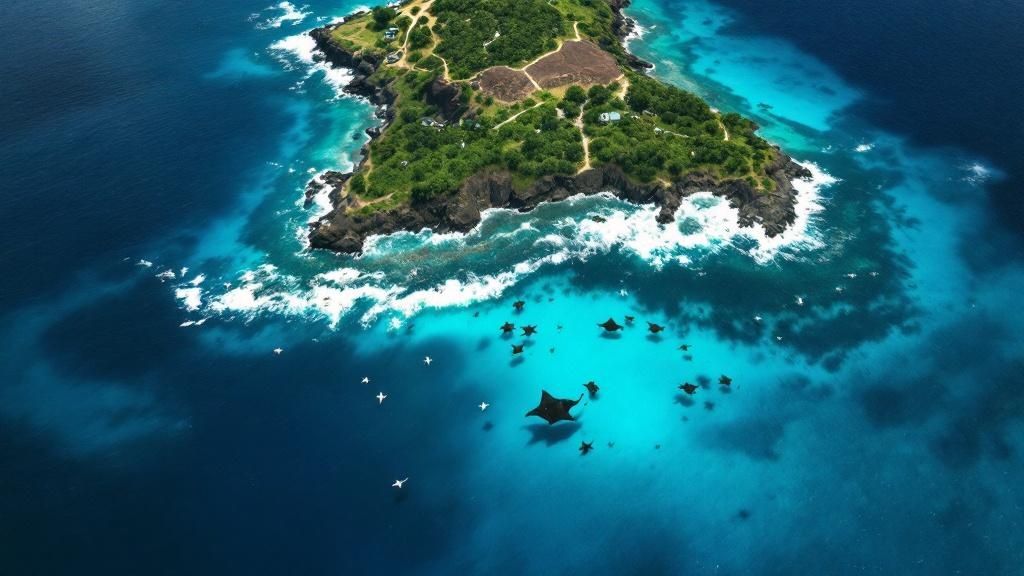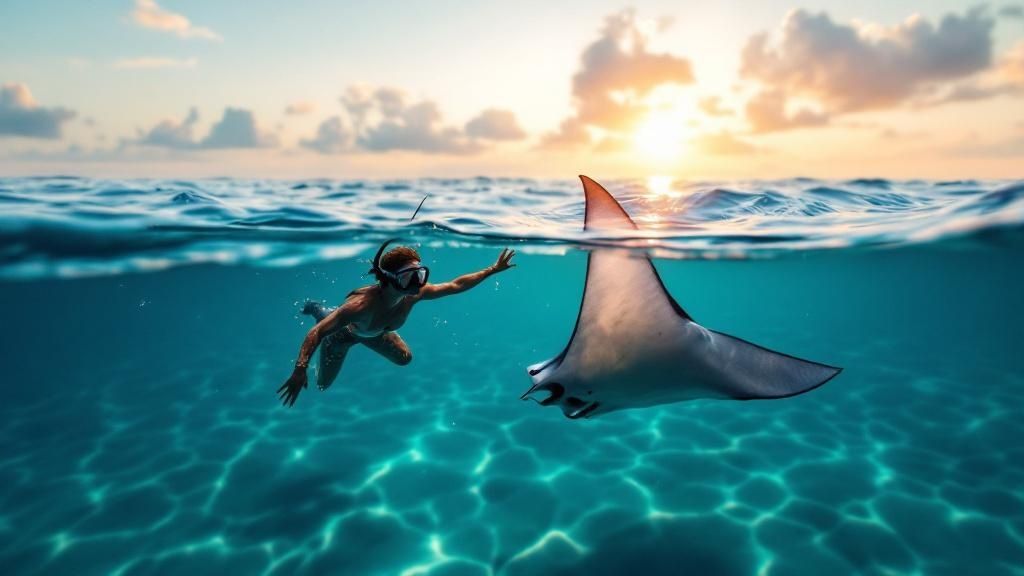Manta Ray Snorkel Kona: Ultimate Guide To Hawaii's Best Tour
- Byron
- Jun 7
- 11 min read
Why Kona Dominates The Global Manta Ray Scene

Kona, Hawaii, is more than just a tropical getaway; it's the manta ray capital of the world. But what makes Kona so special for these gentle giants? It's a unique blend of environmental factors that create the perfect feeding ground.
Volcanic activity plays a key role. Nutrient-rich lava rock off the Kona coast forms the base for thriving coral reefs. These reefs support a diverse ecosystem, including the microscopic plankton that manta rays feed on.
Ocean currents around the Big Island also create upwellings, bringing nutrient-rich water to the surface. This fuels massive plankton blooms, providing a constant feast for the manta rays. This reliable food source contributes to Kona's high manta ray population.
In fact, Kona boasts an 85-90% year-round sighting success rate for manta ray night dives. This makes it a top destination for manta ray enthusiasts worldwide. This remarkable consistency is thanks to the nutrient-rich upwellings supporting a thriving population of over 450 manta rays. Explore this topic further
Kona's Manta Ray Hotspots: Keauhou Bay and Manta Village
Some spots along the Kona coast are especially famous for manta ray sightings. Keauhou Bay, home to Manta Village, is one such hotspot. The bay's shallow, calm waters and consistent plankton blooms create an ideal manta ray feeding ground. The protected bay also offers a safe haven for these incredible creatures.
Another popular spot is Manta Heaven, located off the coast of Kona International Airport. True to its name, this site offers fantastic opportunities to see manta rays in action. The ocean floor and currents create a natural "bowl" that concentrates plankton, attracting large numbers of mantas.
The Manta Ray Feeding Frenzy
Witnessing manta rays feed in Kona is a truly remarkable experience. Attracted by the underwater lights used on night dives and snorkel tours, the mantas perform captivating barrel rolls and chain feeding. They gracefully glide through the water, mouths wide open, filtering plankton. This unique feeding behavior, along with the high sighting rates, solidifies Kona's place as the ultimate manta ray viewing destination.
What Makes These Underwater Encounters So Magical
Manta ray snorkeling in Kona is an experience that stays with you long after you've left the water. It's more than just a fun activity; it's a truly special encounter. Imagine a 20-foot wingspan gliding effortlessly above you, a silent display of grace and power. These gentle giants are often curious about humans, approaching with what seems like peaceful intentions.
A Dance of Feeding: Barrel Rolls and Synchronized Swimming
Watching manta rays feed is a remarkable experience. Attracted by plankton illuminated by underwater lights, they perform captivating barrel rolls, spiraling through the water like acrobats. They also engage in chain feeding, where multiple mantas line up to consume the concentrated plankton. This synchronized movement looks almost choreographed, a beautiful natural spectacle.
Unique Personalities and Distinctive Spots
Beyond their size and graceful movements, each manta ray has a unique personality. Researchers identify individual mantas by the distinctive spot patterns on their underbellies, much like fingerprints. Learning about these markings helps you connect with these intelligent creatures on a deeper level. You might be interested in: Why Manta Ray Night Snorkel Is the Ultimate Adventure in Kona
The Magic of Kona: High Success Rates and Unforgettable Experiences
Manta ray snorkeling in Kona, Hawaii, is known worldwide for its high encounter rates. Approximately 80,000 people each year go manta ray snorkeling, drawn by the impressive 80-90% chance of seeing these majestic creatures. Discover more insights about Kona's manta ray snorkeling success This consistent success rate, combined with the unique feeding displays and the chance to connect with individual mantas, makes this experience one of the most memorable wildlife encounters. It's an adventure that often exceeds expectations, creating a lifelong appreciation for the ocean and its inhabitants.
Finding The Perfect Tour For Your Adventure

Not all manta ray snorkel tours in Kona are the same. Choosing the right tour operator can make a big difference to your overall experience. This means thinking about several important factors to guarantee an unforgettable adventure.
Key Factors for an Exceptional Manta Ray Snorkel Kona Experience
From the quality of the boat and the size of the group to the guide's knowledge and the safety measures, the details truly matter. Boat quality impacts comfort and stability, which is especially important for those who get seasick. Smaller groups often mean more individual attention from guides and a less crowded viewing area.
Expert guides do more than just find manta rays. They provide fascinating information about manta ray behavior, biology, and conservation efforts. This turns a simple sighting into a rich learning experience. Guides also play a critical role in making sure safety procedures are followed, protecting both the participants and the manta rays themselves.
Some tour operators specialize in particular areas, such as photography or sunset cruises. Understanding these different tour styles helps you match your choice to your interests and comfort level.
To help you compare different tours, we've put together a table summarizing key features of some popular operators:
To help you compare different tours, we've put together a table summarizing key features of some popular operators:
Kona Manta Ray Tour Comparison
Comparison of top-rated manta ray snorkel tour operators in Kona, including group sizes, success rates, and unique features.
Tour Operator | Group Size | Success Rate | Duration | Special Features |
|---|---|---|---|---|
Big Island Divers | 6-12 | 95% | 2 hours | Underwater photography assistance |
Manta Adventures | 10-20 | 90% | 1.5 hours | Snacks and drinks provided |
Kona Honu Divers | 4-8 | 98% | 2.5 hours | Small, intimate groups |
Sea Quest Hawaii | 8-16 | 92% | 2 hours | Focus on education and conservation |
Hang Loose Boat Tours | 12-24 | 88% | 1.5 hours | Budget-friendly option |
This table gives you a quick overview of some of the key differences between tours, allowing you to compare group sizes, success rates, and special features. Remember to check recent reviews and verify the information directly with the operators before booking.
Insider Tips for Booking Your Manta Ray Snorkel Kona Adventure
Booking ahead of time, especially during the busy season, is strongly recommended. This helps you secure a place on the tour you want and avoids disappointment. Also, think about the time of year and the moon phase. Plankton activity, which influences manta ray feeding behavior, is affected by these factors. Some operators offer special tours for photography or combine sunset cruises with the manta ray viewing experience. Check out our guide on the best manta ray night snorkel tours in Kona for more details.
By doing your research, comparing various tour operators, considering important factors like boat quality and guide experience, and using these insider tips, you'll find the perfect Kona manta ray snorkel tour for a truly memorable experience.
Your Step-By-Step Manta Ray Experience

Your manta ray snorkel Kona adventure begins well before you even get wet. The excitement starts with the anticipation of seeing these incredible creatures and grows with thorough preparation and expert guidance.
Preparing for Your Adventure: Briefings and Equipment
The experience usually begins with a detailed briefing from your tour guides. This briefing covers manta ray behavior, important safety procedures, and how to respectfully interact with these gentle giants. You'll learn about the special equipment, including the flotation devices that comfortably keep you at the surface and the underwater lights used to attract plankton, which creates a captivating feeding display for the mantas.
After the briefing, you’ll be equipped with all the necessary gear. Most tours provide wetsuits, masks, snorkels, and fins. Many also offer flotation aids like pool noodles or life vests so everyone feels safe and comfortable in the water, regardless of their swimming skills.
Entering the Water and Witnessing the Magic
Once you arrive at the designated manta ray viewing location, usually Manta Village or Manta Heaven, it’s time to enter the water. Most tours follow a structured approach using a floating platform with bright lights. While holding onto the platform, you'll have an unparalleled view of the amazing show. The lights attract plankton, which then draws the manta rays, sometimes just inches below you.
Typical Dive Patterns and Underwater Communication
The experience is led by trained guides, who ensure both your safety and the well-being of the manta rays. They employ specific dive patterns and underwater communication to maximize viewing opportunities while minimizing disruption to these gentle giants. They can often identify individual mantas by their unique spot patterns, sharing interesting information about their behavior and history.
Managing Common Concerns and Maximizing Your Experience
If you're concerned about water temperature or visibility, Kona’s waters are typically calm and clear. Wetsuits offer warmth and the underwater lights enhance visibility, creating a surreal and captivating atmosphere. Remember to stay calm and relaxed; the mantas are curious and peaceful animals.
Your guides will be available to assist you, making sure you get the most out of your manta ray snorkel Kona experience. This adventure is more than just seeing marine life; it's about respectfully and sustainably connecting with these majestic creatures.
Protecting These Gentle Giants Through Responsible Tourism
Understanding your role in manta ray conservation transforms your manta ray snorkel Kona tour from simple entertainment into meaningful participation in marine protection. Globally, manta rays face challenges like habitat destruction and fishing bycatch. However, Kona's tourism industry actively contributes to their survival.
Research and Conservation Efforts in Kona
Your participation in a manta ray snorkel Kona adventure directly supports vital research initiatives. Photo identification programs, for example, allow scientists to track individual mantas, recognizing them by their unique spot patterns. This helps monitor population health, track movements, and understand their life cycle.
This data helps inform conservation strategies and policies that protect these gentle giants and their habitat. Manta Ray Advocates Hawaii has documented sighting statistics along the Kona Coast back to 2009, further contributing to our understanding of these animals. The consistent presence of manta rays in Kona highlights the area's favorable conditions. Find more detailed statistics here
Responsible Snorkeling Practices
Responsible snorkeling practices are essential for minimizing our impact on these sensitive creatures. Maintaining a respectful distance, typically 10 feet, allows mantas to feed and interact naturally without feeling threatened.
Avoid sudden movements or attempts to touch them, as this can disrupt their feeding patterns and cause stress. Just like humans, startled or stressed animals behave differently. Our goal is to observe them in their natural state.
Funding Conservation Through Tourism
Choosing a responsible manta ray snorkel Kona tour operator is crucial. These tours directly fund local conservation efforts and the maintenance of marine protected areas. This ensures future generations can also enjoy these magical encounters.
This symbiotic relationship between tourism and conservation is a model for sustainable wildlife interactions. By supporting responsible operators, you’re not just having a good time; you're investing in the long-term health of Hawaii’s marine ecosystem. This ensures that both the mantas and the local community benefit from your visit. This means the money you spend on your tour helps protect these creatures and their environment.
Strategic Planning For Your Perfect Encounter

Planning your Kona manta ray snorkel adventure should be a thoughtful process. Understanding manta ray behavior and Kona’s environment can transform your trip from ordinary to extraordinary. Consider the best time of year, the moon's influence, and how to prepare for this unique experience.
Timing Is Everything: Seasonal Considerations For Manta Ray Snorkel Kona
Manta rays grace Kona's waters year-round. However, some seasons offer better conditions than others. The summer months (June-September) generally have calmer seas and warmer water. These are ideal snorkeling conditions. The winter months (December-March) can also boast excellent visibility, but the water will be cooler.
Weather can also affect tour operations. Strong winds or rough seas, particularly during winter, can lead to cancellations. Be sure to consider potential weather disruptions when planning and remain flexible with your schedule.
To help you plan your trip, we've put together a handy guide outlining what to expect each month:
To help you plan your snorkeling adventure, we've compiled a helpful guide breaking down the optimal conditions and manta ray activity each month:
Seasonal Manta Ray Activity Guide
Month | Water Temperature | Visibility | Manta Activity | Weather Conditions | Booking Tips |
|---|---|---|---|---|---|
January | Cooler | Excellent | Moderate | Can be windy | Book in advance |
February | Cooler | Excellent | Moderate | Can be windy | Book in advance |
March | Mild | Very Good | Increasing | Variable | Book in advance |
April | Mild | Very Good | Increasing | Variable | Recommended |
May | Warming Up | Very Good | Active | Generally Calm | Recommended |
June | Warm | Good | Very Active | Generally Calm | Book early |
July | Warm | Good | Very Active | Generally Calm | Book early |
August | Warm | Good | Very Active | Generally Calm | Book early |
September | Warm | Good | Very Active | Generally Calm | Book early |
October | Cooling Down | Good | Active | Variable | Recommended |
November | Cooling Down | Good | Active | Variable | Recommended |
December | Cooler | Excellent | Moderate | Can be windy | Book in advance |
This table provides a general overview, and conditions can vary. Always check with your tour operator for the most up-to-date information.
The Lunar Cycle: How The Moon Affects Manta Ray Feeding
The moon plays a significant role in manta ray feeding patterns. New moon periods, with their dark night skies, are ideal for manta ray viewing. The darkness enhances the underwater lights used to attract plankton, the manta rays' primary food source. This often leads to mesmerizing feeding frenzies.
Preparing For Your Adventure: Packing And Mental Readiness
Preparing for your Kona manta ray snorkel tour involves both practical packing and mental preparation. A wetsuit or rashguard is recommended, even in summer, to combat the cool night-time water. Don't forget a towel, warm clothes for afterward, and waterproof sunscreen. If you're prone to seasickness, motion sickness medication is a good idea.
Mentally preparing can also enhance your experience. For nervous swimmers or first-time snorkelers, review our 10 manta ray snorkel tips for helpful advice. Remember, experienced guides are there to support you, ensuring a safe and enjoyable encounter.
Combining Your Tour With Other Kona Attractions
Kona offers a variety of activities beyond manta ray snorkeling. Consider pairing your tour with other adventures. Explore a volcano, visit a coffee plantation, or delve into local history. This maximizes your time in Hawaii and creates a well-rounded vacation.
Booking Strategies For Peak Season
Booking your manta ray snorkel adventure ahead of time, especially during peak season, is essential. Tours tend to fill up quickly, so booking early avoids disappointment. Some operators offer discounts for multiple tours or group bookings, so inquire about these options.
While Kona boasts high manta ray sighting rates, remember that sightings aren't guaranteed. Managing your expectations ensures you'll still appreciate the ocean's beauty and the overall experience, regardless of manta ray activity levels.
Maximizing Your Underwater Magic Moments
Preparing for your manta ray snorkel Kona adventure is just as important as getting ready for a big event. Just like you'd learn the lyrics before a concert, understanding what to expect and how to behave will elevate your manta ray experience from ordinary to extraordinary.
Mastering Underwater Positioning and Movement
Proper positioning is crucial for optimal manta ray viewing. Imagine trying to watch a parade from behind a crowd; you wouldn't see much! Your guides will lead you to the best viewing spots, allowing you to see the mantas clearly without disturbing them.
Moving gracefully is also essential. Think of yourself as a guest in the mantas’ home. You wouldn't run around shouting! Avoid sudden movements and let the mantas approach you. This respectful behavior creates a more natural and unforgettable encounter.
Breathing Techniques and Extended Surface Time
Mastering your breathing techniques will help you stay underwater longer and immerse yourself in the manta ray magic. Much like runners use breathing techniques for better performance, controlled, deep breaths while snorkeling conserve air and enhance your overall experience. This means more time to enjoy the incredible underwater world.
Capturing the Magic: Underwater Photography and Videography
Even with basic equipment, you can capture stunning photos and videos of your manta ray encounter. Just like you don’t need a professional kitchen to cook a delicious meal, you don't need expensive equipment to capture amazing memories. A few simple techniques, like adjusting your white balance and focusing on the manta's eyes, can greatly improve your shots. Your guides can also provide helpful tips for getting the best angles and lighting. On average, you might see three mantas per dive, which helps cement Kona's reputation as the 'Manta Ray Capital of the World'. The combination of warm, clear waters and the unique underwater light show created by dive lights makes the experience even more spectacular. Discover more insights about manta ray sightings
Understanding Manta Ray Behavior and Identification
Experienced guides can teach you how to interpret manta ray behavior. Like birdwatchers identifying different species, they can even recognize individual mantas by their unique markings. This deeper understanding creates a more meaningful connection with these gentle giants. You won't just be watching mantas; you'll be learning about their individual stories and behaviors.
Ready for an unforgettable manta ray adventure in Kona? Book Your Manta Ray Snorkel Adventure with Manta Ray Night Snorkel Hawaii today!
Comments